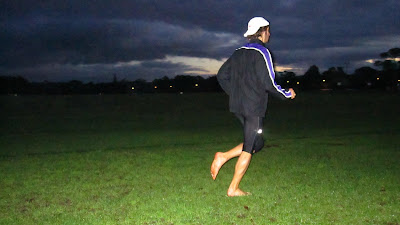I admit it. I’m one of those freak dreamers out there you may see running barefoot. But, as John Lennon, one of the greatest barefoot hippies would say, “I’m not the only one”. Going natural and leaving your running shoes home is becoming ever more popular.
A recent study published in the well-known weekly journal of science Nature claims humans can and did run comfortably without running shoes.
The study, developed by the skeletal biology lab at Harvard University in the United States, showed how running shoes change mechanics and running style. Their shape, providing a fat heel prompts a foot strike where the heel absorbs most of the impact and passes it on to joints and bones. A lot of muscles in the lower leg don’t work. Running shoes also reduce sensory feedback. If you don’t believe it, you just need to run five minutes barefoot and the next day you will feel muscles in your lower leg you didn’t even know were there.
The Harvard team went to Kenya to analyse running style of people who had never worn shoes in their life. They found the foot strike of these people was by contrast on the forefoot. This foot strike reduces impact on joints and bones, which is taken by muscles and tendons.
“[Running barefoot] creates a better forefoot strike which causes less impact. You run from core and pelvis and it makes you think about your running style,” says Sydney-based podiatrist Brent Goddard.
Professor Lieberman was in charge of the study. In this video he explains in detail their findings.
The study was supported by Vibram. This company has created the “barefoot shoes”, commonly known as Five Fingers. The idea is to offer protection to your feet instead of correction as running shoes do or at least try. This is the way a lot of barefoot runners get into barefoot style. In this video you can see a review from Wired science.
MBT shoes or the “antishoes” are another type inspired by nature. The user will shape them while he or she uses them. Their form forces the lower leg muscles to work on your balance.
Big, fat-heeled running shoes are still considered to be the best ones. “The more features the shoes have, the more can go wrong,” says Andrew who has been selling running shoes for the last twelve years. Nonetheless, the shoes market seems still reluctant to change. How could they “encourage” barefoot running? Probably, Nike has made the only approach to this more natural form of running. Nike Free is its bet for the future.
We run barefoot
Why do people go barefoot? Is this trendy and people want to stand out? Or is it just a cool way of saving money? These are some stories of barefoot runners:
- Nick Barlow had been suffering a lot from running injuries and was heading to chronic injury. “I decided I needed to change what I was doing. Initially I tried Nike Frees. They improved things, but I still had nagging injuries. I'd read about barefoot and was certainly attracted to the idea that we didn't evolve with shoes on our feet, but was extremely skeptical as every runner I met was a supporter of running shoes and warned about the "dangers" of barefoot and the need for cushioning. I met a barefoot runner who was lining up with me for a 100km race. This changed my mindset. She too had experienced years of nagging injuries and was unable to run until she changed to barefoot running. I figured if she could complete 100km in Vibram Five Fingers, I could certainly give barefoot running a try. I really had nothing to lose and everything to gain by experimenting. The change to barefoot was startling - after running for only three months barefoot and minimal shoes (Vibram Five Fingers) almost all of my running injuries had gone away. It took almost a year for my injuries to completely disappear and to be running really well barefoot. Almost two years later, I am now running entirely injury free and really enjoying my sport.”
- Alexandre Blanc started using Five Fingers after a repeated tibia stress fracture. “I started by walking with them to reinforce my lower leg and slowly went for a walk/run”. Running barefoot improved his “technique” but also gave him “confidence to run again”.
- Sashipal Singh grew up on the beach. His barefoot style was born with him. A few months ago he discovered Five Fingers. “There is a great tactile feeling. I’ll never go back to my old running shoes…But in the cold weather, they aren’t too great.” He believes Five Fingers to be the precursor for “more contemporary styles that will emerge.” He adds, “To me in a lot of ways it’s a technological and scientific driven movement in shoes.”
- David González has never used Five Fingers. “They would be nice when it’s wet and cold but my feet are already quite tough.” He runs simply barefoot but just for 10 to 15 minutes in every running session. He tried barefoot some months ago after a friend’s advice. “I am convinced that barefoot running improved my technique and strengthened my legs in a better way that all the tough training I did last year.”

David says running barefoot is like a massage for his feet / picture: Alberto Trillo
Not for everyone
All these stories sound like nature knocking on our doors again to sell its incomparable wisdom. Even though running barefoot has proved to be beneficial in the long term, to get into it one must be cautious. “Our new life has given us poor mechanics and we are more prone to injury,” says Andrew, running shoes salesman. This means not everyone is suitable to run barefoot and professional advice should be behind our decision.
In any case, changes need time. Brent Goddard, podiatrist, is afraid people will move “too fast” to barefoot which could mean injuries in the short term. “Five Fingers are potentially harmful and a warning must be around the products,” states Brent.
However, if we speak of the long term, “they are many different exercises and treatments required to encourage better mechanics. Shoes do provide functional benefits but depending on the individual this can be more a short term fix again,” says Andrew.
Common sense appears as the simple rule. “It’s quite individual,” says Brent.
Once again, nature seems to be right, doesn’t it?
































